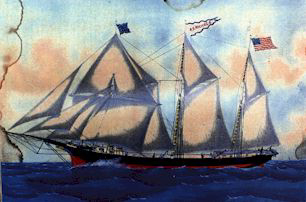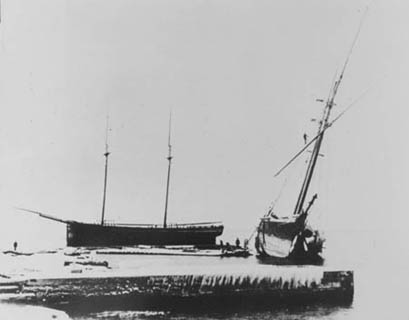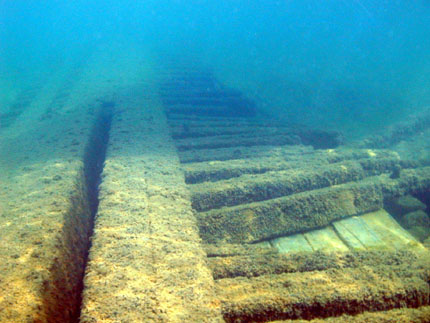Service History
The
A.P. Nichols was built by A. & D.E. Bailey in Madison, Ohio. It was enrolled as a bark on May 8, 1861 under ownership of James Butler and W.E. Sanborn of Buffalo, New York, and was commanded by Captain C. Graves. The vessel was rerigged as a three-masted schooner in 1878. The
Nichols was used for general trade, at points carrying iron ore, grain, and wood throughout the Great Lakes.
It was involved in multiple collisions during its time on the Great Lakes. In September 1861, it collided with the schooner
Rapid in Lake Erie off of Buffalo, New York. On September 24, 1865, it sank the schooner
William O. Brown in a collision at the Bar Point Shoal Light in Lake Erie, and was damaged in another collision in 1869 in Buffalo. The hull of the
Nichols was burned in a Chicago fire on October 1, 1871. Later damage to the vessel include collisions with the propeller
Lake Ontario in Chicago in 1874, and with the schooner
Saveland of Milwaukee in 1885.
Final Voyage
The
A.P. Nichols was bound from Chicago to Escanaba, Michigan during the night of October 28, 1892 when it encountered a gale. The ship turned towards Plum Island, situated in the entrance to Death's Door between Washington Island and the mainland, in hope of finding shelter from the storm. The crew dropped the anchor off Plum Island to avoid washing ashore, but the vessel eventually drifted toward Pilot Island and stranded on the northwest shoal of Pilot Island. Crewmembers escaped to the lighthouse on Pilot Island, where they spent the next few days along with the stranded crew of the
J.E. Gilmore.
In March of 1893, a storm put an end to any hope of recovering the vessel>. The
A.P. Nichols and the
Gilmore broke up and sunk out of sight soon after the storm passed.
An article from the Door County Advocate on February 17, 1894 states, "The schooner
Gilmore is the only one left on Pilot Island. The
Nichols was chucked on the beach in pieces and the previous ones have also disappeared from view."
Today
The wreckage of the
A.P. Nichols is located offshore of the northwest tip of Pilot Island in Lake Michigan, in a strait known as "Porte des Morts," or "Death's Door." The debris is approximately 300 feet west of the cement boat dock, beginning in 20 feet of water and extending deeper. Many large sections of the vessel are present.




 Confirmed Location
Confirmed Location
 Unconfirmed location
Unconfirmed location